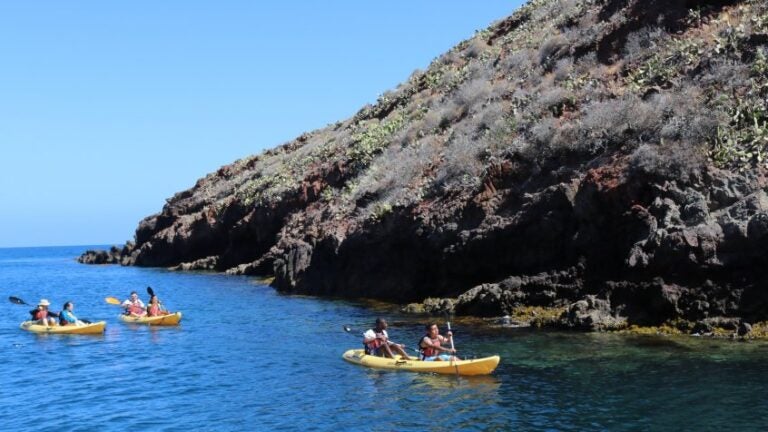
Top Safety Tips for a Safe and Fun Summer by the Water
USC Sea Grant is honored to share our beautiful coastal ocean with many excellent organizations in Southern California who are experts in enjoying water safely. We have compiled a list of top recommendations to keep in mind and resources to use as you head into the summer season!
11 Safety Tips for a Safe and Fun Summer by the Water
1. Learn to Swim
Learning to swim is a great way to enjoy the myriad of pools, lakes, and beaches in Southern California, but it is also a skill that can save your life. Drowning, which can only take a few seconds and very often happens in shallow water, is one of the leading causes of death in kids under the age of 4; never take your eyes off a child in the water. And, it is never too late to learn how to swim. Check out the SwimLA website to locate the closest free or affordable swim lessons for kids or adults.
2. Swim Near a Lifeguard
LA County Lifeguards list swimming near a lifeguard as one of the top summer safety tips; sure enough, the U.S. Lifesaving Association calculates that the chance of drowning at a beach protected by a lifeguard is about 1 in 18 million. Drowning at a beach without a lifeguard is five times as high.
3. Always Enter the Water Feet First
Both the LA County Lifeguards and the U.S. Lifesaving Association emphasize the importance of always entering the water feet first, especially when you are not sure of the depth of the water. Very serious injuries, including paralysis, occur every year from people diving headfirst into the water and striking the bottom.
4. Have a Buddy
Many drownings involve people swimming alone. It is safest to swim with a friend or family member who can go get help if needed. At the very least, you should have someone onshore watching out for you. Children in particular should always have an adult actively watching them in the water.
5. Only Swim if the Water is Clean
Sometimes, beaches in Los Angeles County are closed when there is known sewage or chemical spill impacting ocean waters. Contact with bacteria or chemicals in the water can cause a swimmer or surfer to become ill. If a beach is closed, signs will be posted. Before you leave home, particularly if it has recently rained, check Heal the Bay’s Beach Report Card to find out if your favorite beach has safe water quality.
6. Be Aware of Rip Currents
About 80% of lifeguard rescues in the ocean are caused by rip currents. If you are caught in a rip current, don’t fight it by trying to swim straight back to shore. Swim parallel to shore until you feel the current relax. To learn more about what rip currents look like, check out LA County Lifeguards’ diagram and tips. To learn more about rip current safety, visit the new National Oceanic and Atmospheric Administration (NOAA) and the U.S. Lifesaving Association (USLA) Rip Current Safety Toolkit. You can also watch one of NOAA’s senior scientists talk about rip current awareness.
7. Follow Signs and Flags
Read the signs when you first arrive and please follow their direction. Flags may be flown by lifeguards to advise of hazards. Avoid swimming near piers, docks, and rock structures. When in doubt of the meaning of a flag or sign, ask the lifeguard.
8. Protect Yourself from the Sun
When you are out in the sun, always wear broad-spectrum sunscreen to prevent sunburn which can lead to skin cancer over time. Drink lots of water to avoid dehydration.
9. Do the Stingray Shuffle and Respect All Wildlife
Some Southern California sandy beaches are home to stingrays. They will sting if stepped on. If you shuffle your feet as you move along the bottom, you will warn the stingray you are coming and it will move away. If you are stung, seek lifeguard help immediately. We also have a number of marine mammal species that can be found on beaches in Southern California, most commonly seals and sea lions. Although they may look cute, it is important to keep your distance, approximately 100 yards or the length of a football field. Marine mammals can pass diseases to humans, and bites can be severe. Learn more about how to avoid stingrays, click here. To report a dead, injured, or stranded marine mammal to the West Coast Marine Mammal Stranding Network, please call: 1-866-767-6114
10. Wear a Life Jacket
The vast majority of deaths during boating are people who go overboard without a lifejacket and drown. If you are an adult with questionable swimming skills, you should wear a life jacket at all times on a boat. Children should also always wear life jackets onboard a boat.
11. Boating: Know Before You Go
There are boating rules and safety tips in California to ensure a safe boat outing, so please familiarize yourself with the ABCs of California boating before boating, kayaking, rafting, or canoeing. Most importantly, carrying the proper safety equipment on your boat is the law!
More Resources on Summer Safety:
-
LA County Lifeguard provides both Pool Safety Tips and Beach Safety Tips